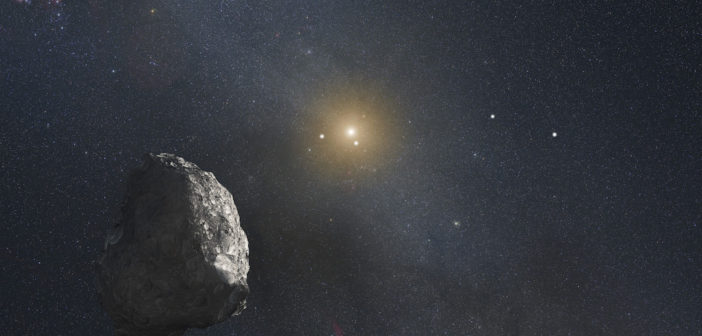Editor’s note: Astrobites is a graduate-student-run organization that digests astrophysical literature for undergraduate students. As part of the partnership between the AAS and astrobites, we occasionally repost astrobites content here at AAS Nova. We hope you enjoy this post from astrobites; the original can be viewed at astrobites.org.
Title: Discovery and Dynamical Analysis of an Extreme Trans-Neptunian Object with a High Orbital Inclination
Author: J. C. Becker, T. Khain, S. J. Hamilton, et al. (DES Collaboration)
First Author’s Institution: University of Michigan
Status: Published in AJ
Three years ago, Mike Brown and Konstantin Batygin published their seminal paper predicting a massive, undiscovered Planet Nine. The publication was quickly picked up by the media and reinvigorated the study of objects beyond the orbit of Neptune, appropriately called trans-Neptunian objects (TNOs). Among the TNOs are Kuiper Belt objects, which have well-behaved orbits, and “extreme” TNOs (ETNOs), which have highly eccentric and inclined orbits.
There are many open questions about ETNOs. Were they born extreme or scattered into extreme orbits later in life? How long will their orbits be stable? How many ETNOs even exist? Does the existence of Planet Nine explain or complicate the population of ETNOs? Few researchers were asking or trying to answer these questions until recently, when the search for Planet Nine uncovered a batch of ETNOs that are more exciting than previously thought.
The Search for Planet Nine Continues
Many telescope surveys have tried without success to find Planet Nine in the three years since the theory was published, leading some astronomers and groups to question the hypothesis. Searching for Planet Nine requires special imaging techniques to identify slowly moving, cold, small objects from a trove of astronomical images, which has had the side effect of producing more discoveries of other types of TNOs.
This is where the Dark Energy Survey (DES) comes in. DES’s five years of high-resolution images have been put through a special pipeline designed to pick out only TNOs through a method called difference imaging. This technique is combined with machine learning to find the faintest TNOs possible and then “connect the dots” of each detection into complete orbits.
Extreme … In a Good Way
This paper reports on DES’s discovery of 2015 BP519, the “most extreme” TNO yet, because it has a highly elliptical orbit with an eccentricity of 0.92 and is inclined a whopping 54° out of the plane of the planets.
The high inclination of this ETNO is puzzling because the solar system formed from a disk, so something would have had to severely disturb the orbit of 2015 BP519. To test that hypothesis, the authors ran a simulation of 2015 BP519 forward and backward in time, showing how it would change orbit by interacting with the current solar-system objects.
Figure 1 shows many individual simulations (red lines) of how orbital inclination (i), eccentricity (e), semi-major axis (a), and perihelion (q) vary over billions of years. Looking backwards in time from today, the simulated inclination and eccentricity do not vary significantly. To the authors, this suggests whatever perturbed this ETNO is missing from the model.

Figure 1. Numerical simulations of 2015 BP519 forward and backward in time interacting with the gas-giant planets. Only the gas giants are simulated because the terrestrial planets contribute negligibly to the overall angular momentum of the solar system. Each red line represents one simulation. Inclination (i), which is the tilt of the orbit, and eccentricity (e), which is the measure of how elliptical the orbit is, do not vary much over billions of years. [Becker et al. 2018]

Figure 2. Simulations of 2015 BP519 as Figure 1, but this time including Planet Nine. Inclination and eccentricity vary far more wildly here, showing how the presence of Planet Nine might explain how 2015 BP519 became so extreme. [Becker et al. 2018]
A Natural Fit
Another analysis of interest from this paper is provided in Figure 3, which plots all known TNOs, where bluer color indicates more “extremeness.” Semi-major axis is plotted on the x-axis versus the orbital elements on the y-axis. These quantities describe the orientation of the orbit in physical space. Figure 3 is quite detailed, but the important point is the higher density of dots in the shaded regions, which was the original impetus for the Planet Nine theory. 2015 BP519, marked by a star, adds another data point to support this theory.

Figure 3. Visualization of orbital elements on the y-axis versus semi-major axis on the x-axis for all known TNOs. Bluer dots represent more extreme orbits. BP519 coincides with the clustering of TNOs in the shaded regions that inspired the Planet Nine hypothesis. [Becker et al. 2018]
About the author, Will Saunders:
I am a first year Ph.D. student at Boston University, where I am trying to decide what to study. I received my Bachelors in Physics from the University of Pennsylvania. In my free time I enjoy listening to podcasts, visiting museums, and tasting new wines.

4 Comments
Pingback: AAS Nova – New
Pingback: Planet Nine Might Be a Black Hole the Size of a Baseball - D-brief
Pingback: Planet Nine Might Be a Black Hole the Size of a Baseball | Technology News and Markets
Pingback: Planet Nine Might Be a Black Hole the Size of a Baseball - Fasti News